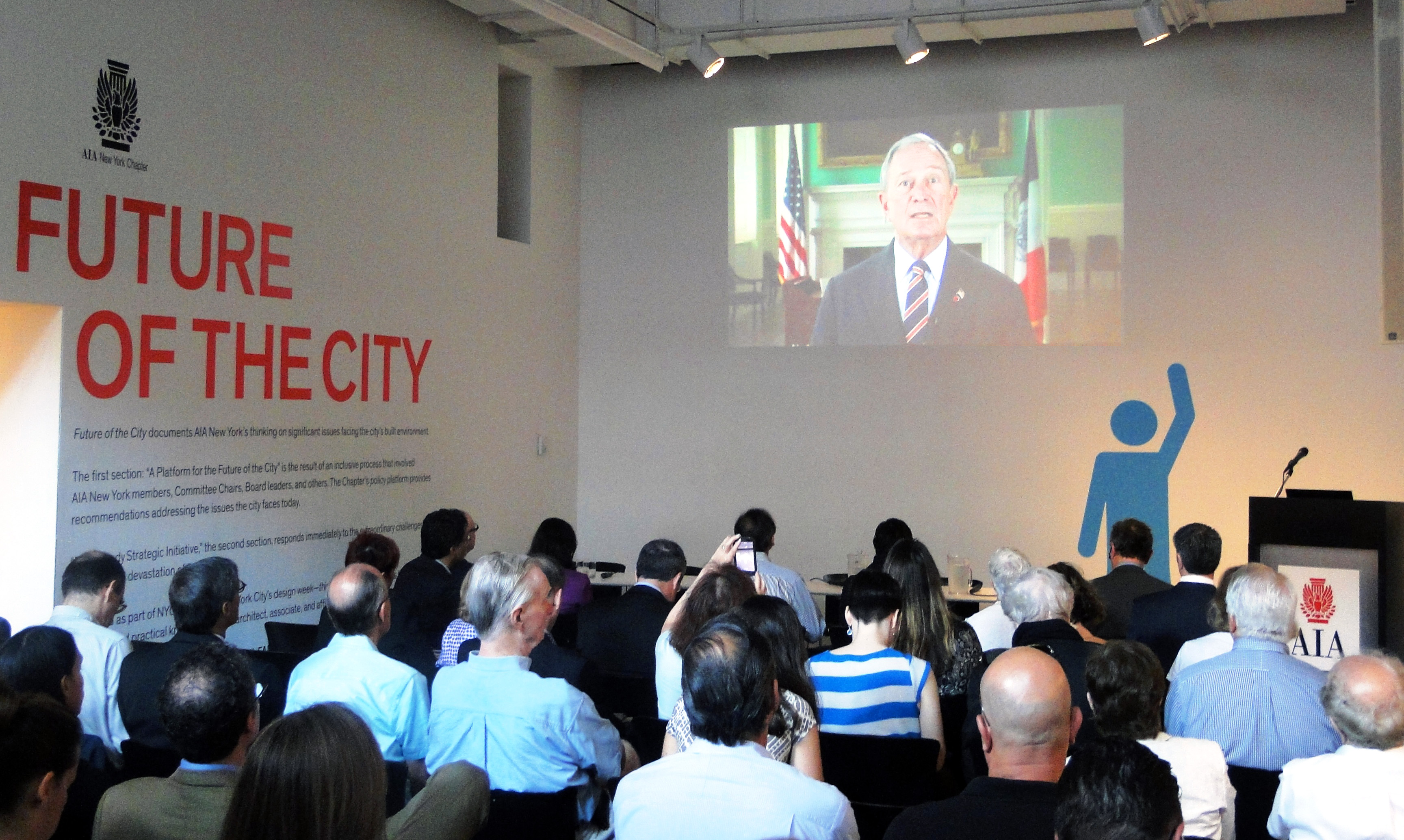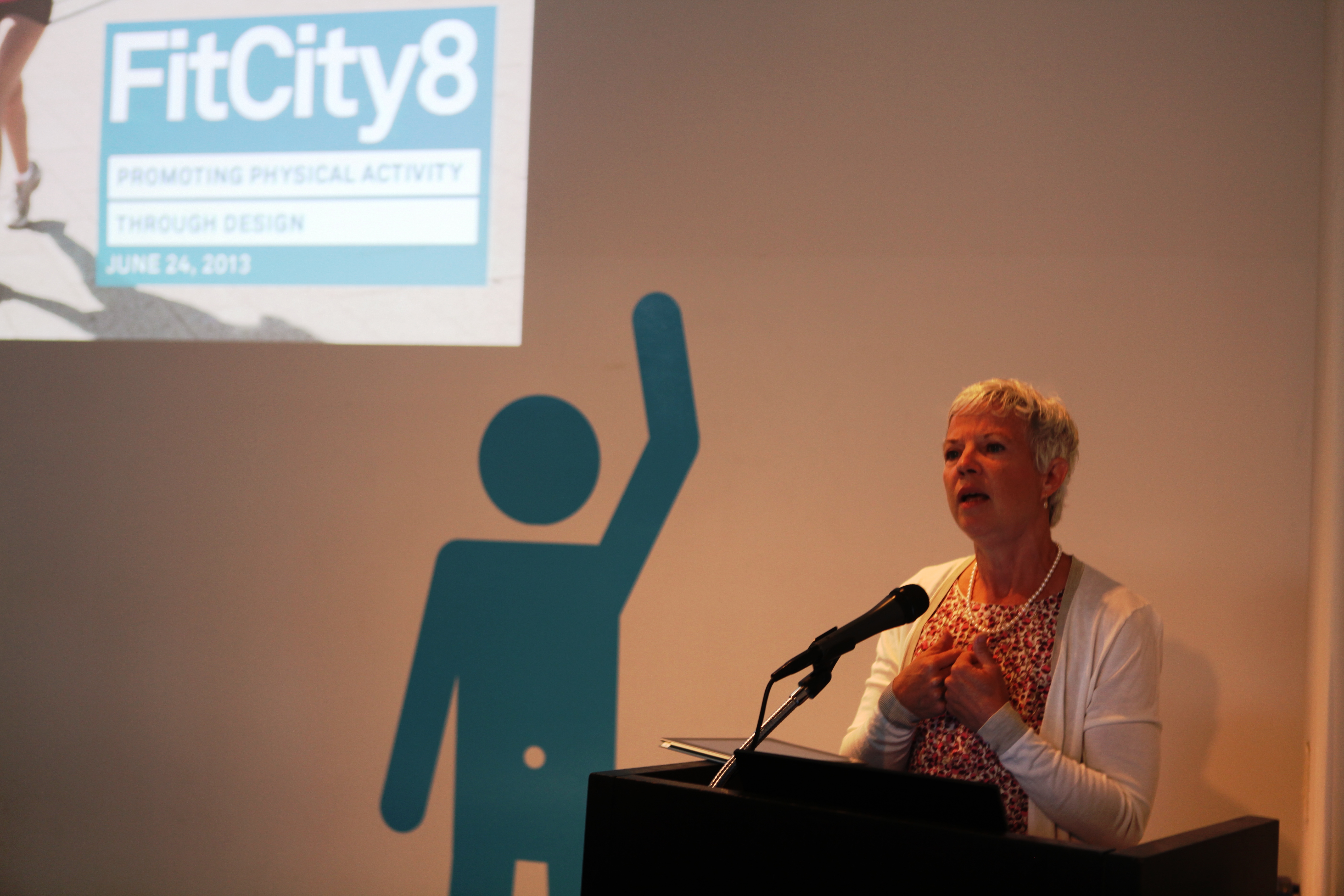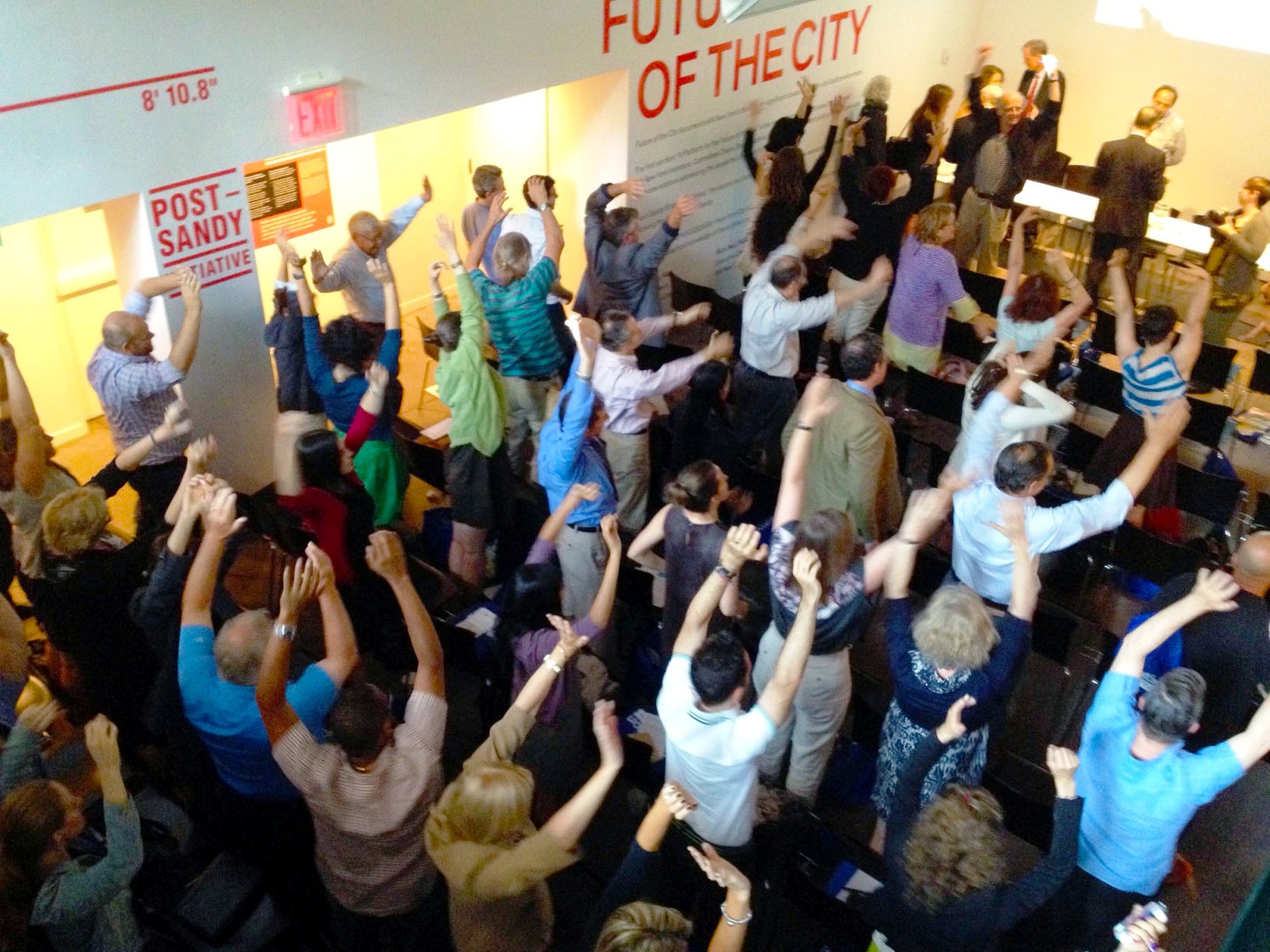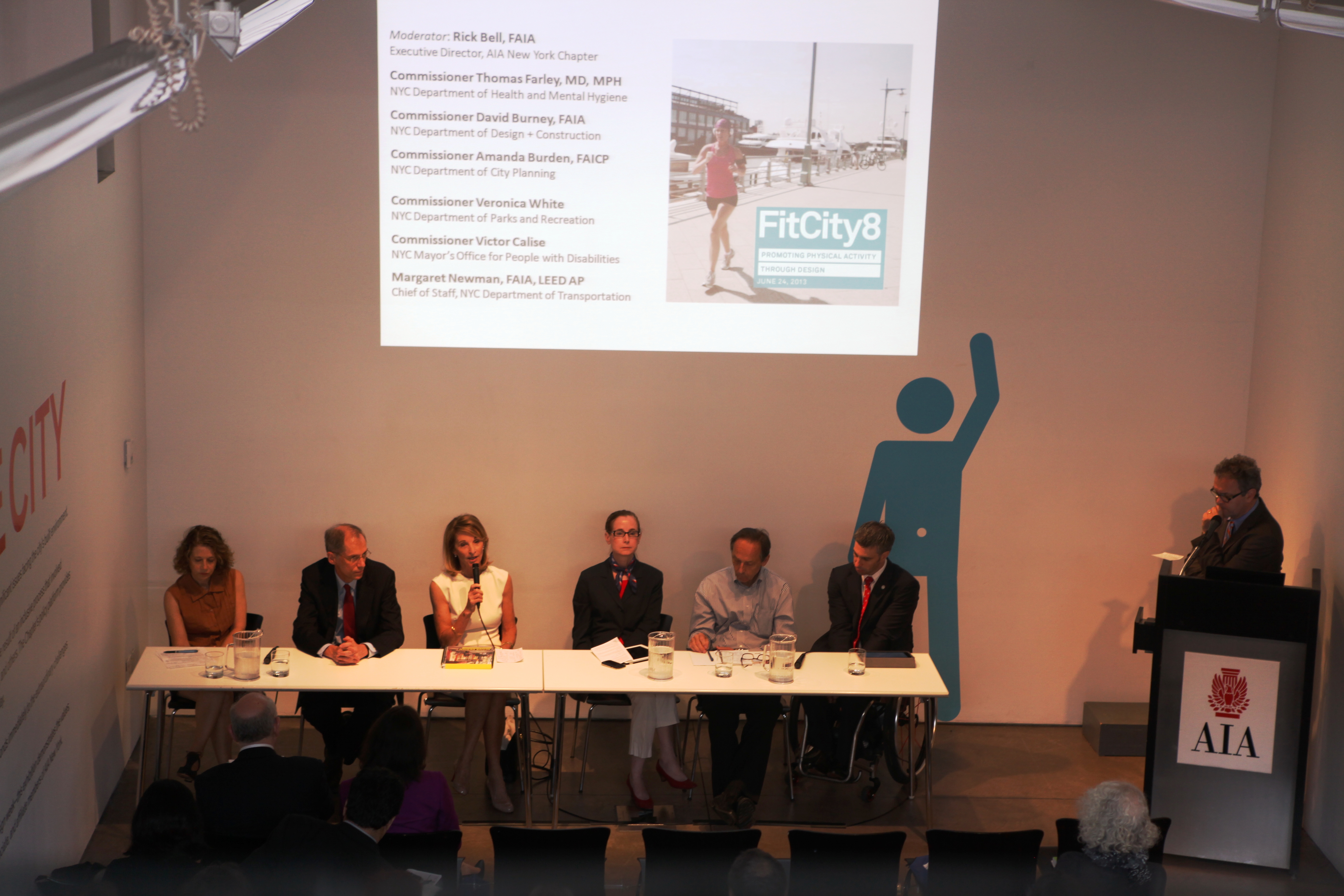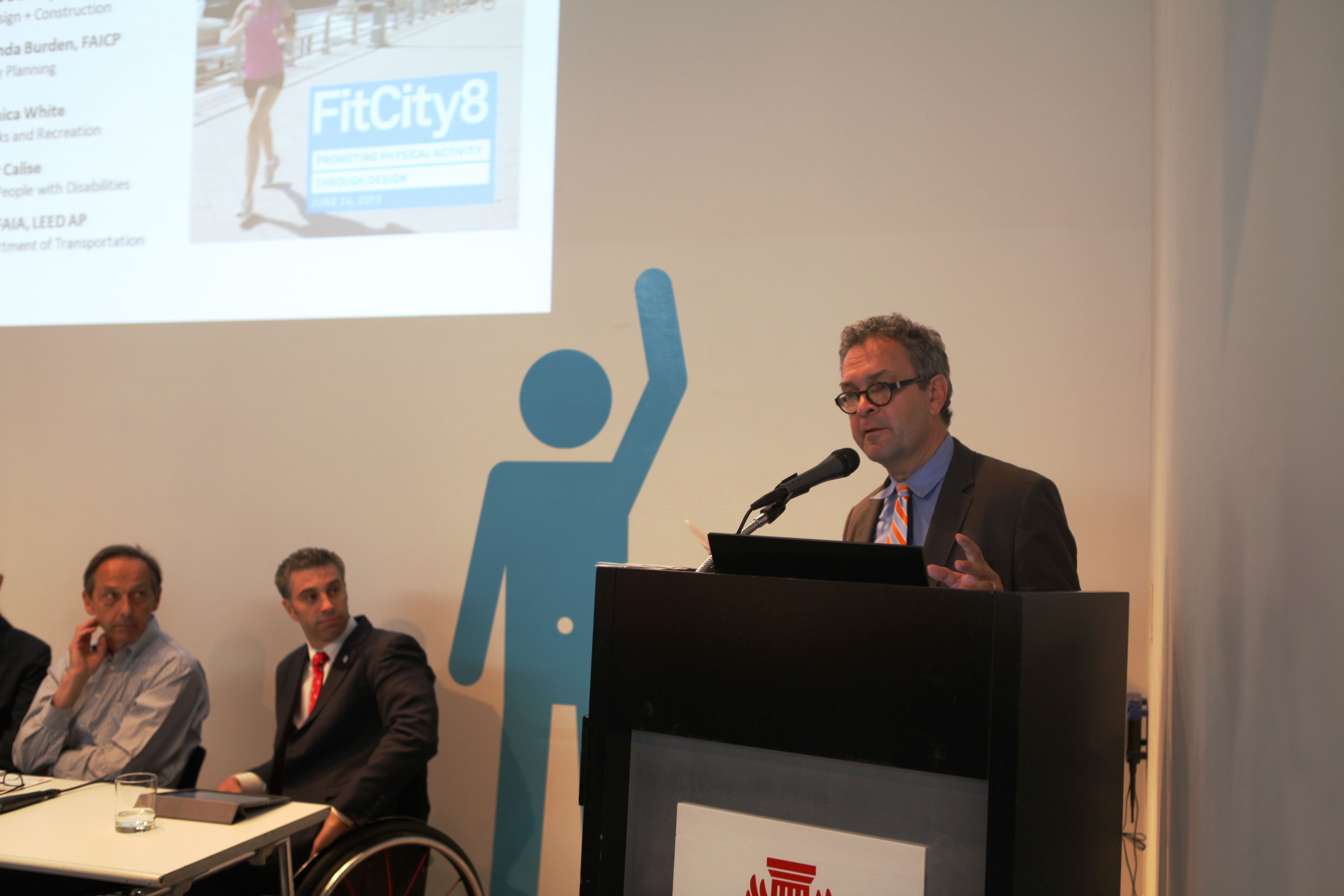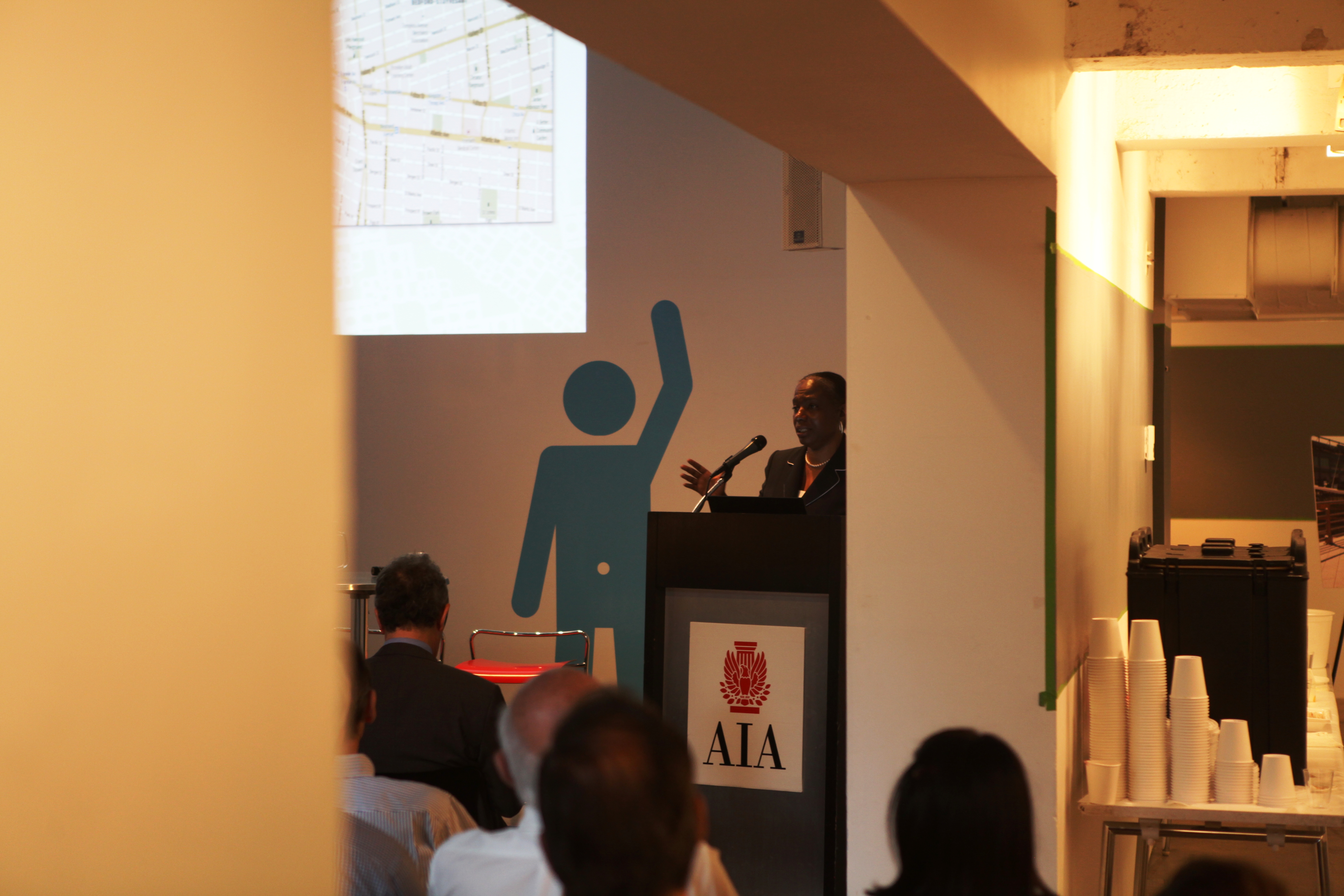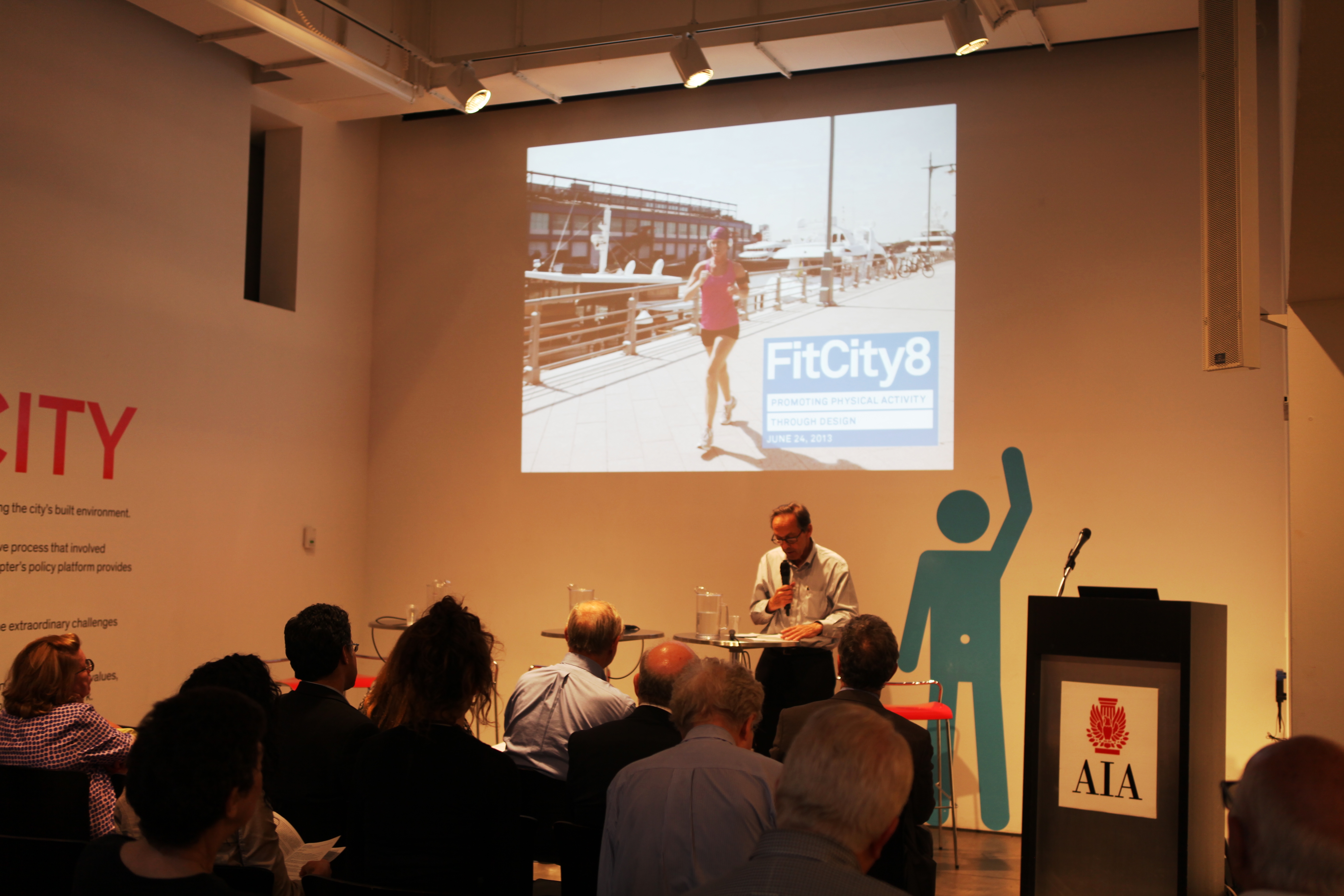by: Bill Millard
Observers looking into the Center for Architecture from the sidewalk on 06.24.13 may have inferred either that every talk given at Fit City 8 was deeply inspiring or that the audience was unusually excitable. From Mayor Bloomberg’s video introduction, to remarks by Deputy Mayor Linda Gibbs and the first keynote speaker – the World Health Organization’s Alex Ross – through the final summation by NYC Department of Design + Construction Commissioner David Burney, FAIA, each presentation ended in a standing ovation.
This wasn’t quite the case: the attendees were following Dr. Karen K. Lee’s recommendation of “active applause,” standing up for each applaudable moment: along with exercises led by the Department of Health’s Sarah Wolf, MPH, RD, and group yoga maneuvers led by Robyne Kassen, Assoc. AIA, and Sarah Gluck of Urban Movement Design, one of several strategies for keeping the blood circulating and staving off the languor that all-day meetings often produce. But Fit City is that kind of event: it translates ideas directly into practice.
As the annual conference reaches its eighth year, there’s no question that the entrenched problems the Active Design movement addresses – adding up to nothing less than “a common philosophical and moral imperative,” in the words of Deputy Mayor Linda Gibbs – justify the series’ longevity.
Still, it’s reasonable to ask what each successive Fit City meeting contributes to the understanding of the relations among design, activity, and the noncommunicable diseases that now outweigh infection as leading public-health concerns (obesity, diabetes, and cardiovascular disorders topping the list). Far from repeating a message that’s become overly familiar, this year’s event highlighted extensions of Active Design strategies into new areas where there’s ample room for progress. Design features and practices that encourage people to improve their caloric input/output balance and make headway against the national obesity epidemic are producing results in community centers and affordable housing, in corporate well-being efforts, and even in the national capital of car culture.
Indeed, Active Design appears to be approaching the condition sustainable design was in 10 or 15 years ago: still a specialty, but one with a broadening evidentiary basis and a strong case for becoming a professional norm.
Monumental staircases in new buildings (plus stair-prompt signage), the Citi Bike program implemented by NYC Department of Transportation (DOT) Commissioner Janette Sadik-Khan, and the mayoral campaign to control soft-drink portion size are all highly visible. As Burney observed during the commissioners’ panel, the soda-size ban, as it works its way through appellate courts, at times seems to be, unfortunately, the only one of the Bloomberg Administration’s 26 major health initiatives to attract any local ink.
A simple statistic, however, may say more about what these efforts are accomplishing: childhood obesity in the city is down 5.5% since 2006. This is only one victory; adult obesity rates continue to rise here as they do nationwide. But the childhood data imply the turning of a tide and the increasing well-being of a generation.
These joint efforts by New York public health officials and architectural leaders are now spreading globally as well as nationally, as the accompanying “FitNation” exhibition and London’s recent Fit Cities-Fit World conference indicate. They have to, and they need to hurry. As Ross from the World Health Organization pointed out with a blizzard of data, world populations are aging and urbanizing quickly, reaching unprecedented conditions that strain health resources. Japan leads the way in aging, skewing toward the elderly while depopulating, changing the “dependency ratio” of younger workers to seniors from 9:1 around World War II to a projected 1:1 two decades from now; laws in Japan and China are now adapting to such a social structure, Ross noted, by letting parents sue their adult children for nonsupport. High-sodium diets, particularly prevalent in East Asia (where hypertension is rife) and persistent problems with road safety (only 28 nations worldwide have comprehensive laws in this area) amplify the health concerns associated with aging populations.
Yet some nations have made remarkable changes, Finland in particular: dietary and behavioral interventions, first piloted in the North Karelia region, cut deaths due to coronary heart disease (CHD) from the 700/year range per 100,000 population to below 200/year between 1972 and 2005, and the extension of these changes to the whole nation gained Finns, on average, about 10 years of life. What was possible in Finland, where CHD rates were once the world’s highest, indicates what’s achievable elsewhere.
New York remains a model for national Active Design campaigns. NYC Department of Health and Mental Hygiene Commissioner Thomas Farley, MD, MPH, noted that about 21% of New Yorkers are currently defined as inactive, compared with 51% of Americans. The key question, he emphasized, is how to institutionalize these gains.
“Our objective to have a dynamic, vibrant, competitive, equitable, sustainable city is also totally intertwined with a healthy city,” observed NYC Department of City Planning (DCP) Commissioner Amanda Burden, FAICP, Hon. AIANY, but “that might not necessarily be the case.” The strategy to reshape the city through zoning to concentrate development in “complete neighborhoods” within walking distance of transit depends on streetscape design that makes walking attractive.
Consequently, the latest technical supplement released in the multi-agency Active Design Guidelines series, Active Design: Shaping the Sidewalk Experience, presents the thorough research of DCP sSenior Urban Designer Skye Duncan, MsAUD, as presented in detail last year at Fit City 7.
Cycling is another area where recent progress calls for defense and consolidation. NYC DOT Chief of Staff Margaret Newman, FAIA, subbing for Sadik-Khan (who unexpectedly hit the disabled list with a sprained ankle – incurred out of town, Newman pointed out, not on New York’s streets), offered both data and perspective on the achievements of DOT’s recent years, redesigning streets for the first time in 50 years.
The media spotlight during the first month of the Citi Bike program has been bright enough that half the audience questions submitted to moderator Rick Bell, FAIA, AIANY executive director, concerned bicycles. Despite certain overamplified naysayers’ assumption that Citi Bike was sprung overnight on an unprepared city, it rests on six years’ worth of groundwork, not just the hundreds of neighborhood meetings, but 350 miles of bike-lane construction, and the exhibition “Two Wheel Transit: NYC Bike Share” at the Center for Architecture last year on the topic.
Early numbers suggest a thumping success, despite disproportionate attention to the inevitable startup glitches: as of the conference date, there have been 1.1 million total miles ridden, 30,000 daily rides (averaging five uses per bike per day), and nearly 47,000 memberships (far more New Yorkers than visitors).
The most encouraging reports arguably came from a first-time panel on community applications of Active Design. Youth Ministries for Peace and Justice Executive Director David Shuffler, Jr., described grassroots projects within the South Bronx’s highway-delineated “toxic triangle.” Transformations of brownfield areas into Concrete Plant Park and the planned Starlight Park are reconnecting neighborhood segments that the roads divided, and conditions on the Bronx River have improved enough to make canoeing possible.
Tracey Capers of the Bedford-Stuyvesant Restoration Corporation offered comparable stories of new and remodeled plazas helping revitalize Fulton Street. Mt. Sinai pediatrician Elizabeth Garland, MD, MS, described innovative work with Blue Sea Development on the Eltona V and Arbor House projects in the Bronx, green affordable-housing buildings whose staircases feature piped-in music and wittily customized stair-prompt signage; studies tracking residents’ health indicate that symptoms and health-care visits for asthma are already dropping. Joan Blumenfeld, FAIA, LEED ID+C, of Perkins+Will (and 2007 AIANY President) added encouraging data from studies of employee and student performance in buildings with daylight, views, and no toxic materials. A forthcoming Active Design guide, Dr. Lee announced, will extend the principles to community groups.
One theme connecting the various sessions (on community and private-sector endeavors as well as the commissioners’ public-sector work, along with health-oriented and design-oriented keynotes) was an integrated, expanding definition of well-being. The most effective expressions of Active Design affect variables like neighborhood cohesion and personal emotional health as well as body-mass index.
The Nashville-based consulting firm Healthways, represented at Fit City 8 by Sue Schmidt, has helped firms like Caterpillar boost their employees’ well-being, a term she prefers over “wellness.” Her practice includes studying environments’ social, cultural, and financial effects as well as medical outcomes, adjusting these environments to foster behavioral changes, make physical activity a general way of life rather than a specialized activity with a dedicated space (Healthways has no fitness centers), and realizing impressive gains in productivity and employee retention.
Benefits from complete-streets transformations, added Stantec Principal Donna Walcavage, FASLA, LEED AP, extend to businesses: refuting the common complaint that redesigns are bad for commerce, she presented findings attributing retail sales increases of up to 49% on Eighth and Ninth Avenues, and an eye-popping 172% near DUMBO’s pedestrian plaza.
These gains do not represent New York exceptionalism, stressed Los Angeles City Planning Commission President William Roschen, FAIA. Even in the famously car-centric city that “no one ever wants to emulate,” health-based planning is arising through the city’s tricky multicentric political system, discovering ways to regulate fast-food proliferation through urban design codes, opening 113 transit stations, and converting some of an abundant LA resource – paved space – into plazas and “Transit-Enhanced Neighborhoods” (TENs). If healthy design can gain a foothold in LA, it is a resilient enough concept to spread much further.
Developer Les Bluestone of Blue Sea commented that regulatory hurdles aren’t insurmountable: “Just because someone says no, you go out and find the person who says yes. They’re out there.”
The event culminated in a playfully inspiring keynote presentation by Peter Bohlin, FAIA, principal of Bohlin Cywinski Jackson and designer of some of the world’s most elegant residential and commercial spaces, including Apple Retail Stores centered around transparent staircases, houses that merge with surrounding woodland and encourage hiking or swimming, and the bridges, water feature, plazas, and stairs of the Seattle City Hall, deftly interwoven on a steeply angled site. The poetry and serenity of Bohlin’s buildings suggest that Active Design has endless possibilities aesthetically as well as functionally. From his perspective, there’s no tension between the two: “I never saw it as purely spiritual,” he said, “although it is. It’s also sensible.”
Event:Fit City 8: Promoting Physical Activity through Design
Location: Center for Architecture, 06.24.2013
Speakers: Hon. Linda I. Gibbs, Deputy Mayor for Health and Human Services; Jill N. Lerner, FAIA, 2013 President, AIANY; Susan Kansagra, Health Promotion and Disease Prevention Acting Deputy Commissioner, NYC Department of Health and Mental Hygiene; Karen K. Lee, MD, MHSc, FRCPC, Built Environment and Healthy Housing Senior Advisor, NYC Department of Health and Mental Hygiene (panelist, Active Design and Community Well-Being, and health keynote introduction); Alex Ross, Director, World Health Organization Centre for Health Development, Kobe, Japan (healty keynote); Rick Bell, FAIA, Executive Director, AIANY (moderator, Growing Active Design: Commissioners’ Panel); Commissioner Thomas Farley, MD, MPH, NYC Department of Health and Mental Hygiene; Commissioner David Burney, FAIA, NYC Department of Design + Construction (panelist and closing remarks); Commissioner Amanda Burden, FAICP, Hon. AIANY, NYC Department of City Planning; Margaret Newman, FAIA, LEED AP, Chief of Staff, NYC Department of Transportation; Commissioner Veronica White, NYC Department of Parks and Recreation; Commissioner Victor Calise, NYC Mayor’s Office for People with Disabilities; Sarah Wolf, MPH, RD, NYC Department of Health and Mental Hygiene (physical activity break); Sean I. Robin, MCP, Built Environment and Healthy Housing Director, NYC Department of Health and Mental Hygiene (moderator, Active Design and Community Well-Being): Sean I. Robin, MCP, Built Environment and Healthy Housing Director, NYC Department of Health and Mental Hygiene; David Shuffler, Executive Director, Youth Ministries for Peace and Justice; Tracey Capers, Executive Vice President, Bedford Stuyvesant Restoration Corporation; Elizabeth J. Garland, MD, MS, Associate Professor, Departments of Preventive Medicine and Pediatrics, Icahn School of Medicine at Mount Sinai; Joan Blumenfeld, FAIA, Interior Design Director, Perkins+Will; Joanna Frank, Active Design Director, NYC Department of Design + Construction (moderator, Active Design and Private Sector Well-Being); William Roschen, FAIA, President, Los Angeles City Planning Commission; Les Bluestone, President, Blue Sea Development Co.; Donna Walcavage, FASLA, LEED AP, Principal, Stantec; Sue Schmidt, Senior Principal, Well-Being Design Healthways, Inc.; Robyne Kassen, Assoc. AIA, and Sarah Gluck, Urban Movement Design (Active Design Breakout Group Exercise); Skye Duncan, MsAUD, Senior Urban Designer, NYC Department of City Planning (design keynote introduction); Peter Q. Bohlin, FAIA, Principal, Bohlin Cywinski Jackson (design keynote)
Organizers: AIANY, New York City Department of Health and Mental Hygiene








